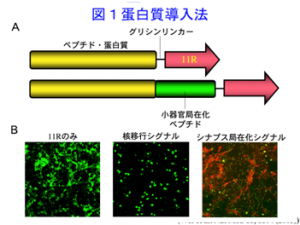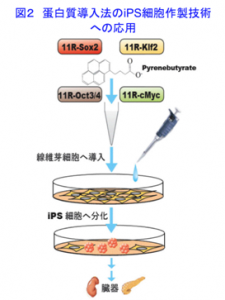蛋白質導入法とは、膜透過性ペプチド(cell-penetrating peptide, CPP)と呼ばれるペプチドを付加することにより蛋白質、ペプチド、低分子化合物などを細胞内に導入し機能させる技術であります。1988年2つのグループからヒト免疫不全ウイルスⅠ型(HIV-1)が発現するTrans-activator of transcription protein (TAT蛋白質)を培養液中に添加すると細胞膜を通過し細胞内に移行することが 報告されました。その後、TAT蛋白質の11個のアミノ酸からなるドメイン(protein-transduction domain (PTD))が膜透過性の性質を有していることが判明しております。TAT蛋白質のPTDの特徴は、11個のアミノ酸の内、8個のアミノ酸がアルギニンならびにリジンの塩基性アミノ酸で構成されていることであります。このことから、正電荷を帯びていること が膜透過性に重要であることが示唆されたため、我々はTAT蛋白質のPTDをすべてアルギニンに置換したCPPペプチドを作製し(11R)、蛋白質・ペプチドの細胞内導入効率についてTAT蛋白質のPTDと比較いたしました。すると11Rが、約5倍導入効率が高いことが明らかになりました。また11Rとともに細胞内小器官局在化シグナルペプチドを付加しますと、導入した蛋白質・ペプチドを細胞内の小器官でのみ機能させることができます(図1)。
報告されました。その後、TAT蛋白質の11個のアミノ酸からなるドメイン(protein-transduction domain (PTD))が膜透過性の性質を有していることが判明しております。TAT蛋白質のPTDの特徴は、11個のアミノ酸の内、8個のアミノ酸がアルギニンならびにリジンの塩基性アミノ酸で構成されていることであります。このことから、正電荷を帯びていること が膜透過性に重要であることが示唆されたため、我々はTAT蛋白質のPTDをすべてアルギニンに置換したCPPペプチドを作製し(11R)、蛋白質・ペプチドの細胞内導入効率についてTAT蛋白質のPTDと比較いたしました。すると11Rが、約5倍導入効率が高いことが明らかになりました。また11Rとともに細胞内小器官局在化シグナルペプチドを付加しますと、導入した蛋白質・ペプチドを細胞内の小器官でのみ機能させることができます(図1)。
これまで我々は、岡山大学・細胞生理学研究室 と共同で本技術を用いた抗癌性蛋白質導入技術、ペプチド性免疫抑制剤、神経保護作用を 有する膜透過性ペプチド、あるいは育毛作用のあるペプチド開発などを行ってまいりました。また、本技術を応用したiPS細胞の作製に取り組んだり、あるいはiPS細胞から膵β細胞などへの分化誘導技術の開発に取り組んだりしています。iPS細胞を再生医療分野で臨床応用するためには、iPS細胞やiPS細胞から分化させた細胞や組織の安全性が十分保証されている必要性があり、ウイルスベクターを使用しない安全な技術開発が望まれています。私たちは、蛋白質導入法により遺伝子を導入するのではなく、遺伝子産物である蛋白質を直接細胞に導入することによる安全な技術開発を行っています(図2)。蛋白質を導入した場合、染色体への影響が無く、また速やかに分解されるため長期間細胞に影響を及ぼしません。本研究を通して安全なiPS細胞作成技術ならびにiPS細胞分化誘導技術を開発し、iPS細胞の臨床応用に繋げたいと考えています。
と共同で本技術を用いた抗癌性蛋白質導入技術、ペプチド性免疫抑制剤、神経保護作用を 有する膜透過性ペプチド、あるいは育毛作用のあるペプチド開発などを行ってまいりました。また、本技術を応用したiPS細胞の作製に取り組んだり、あるいはiPS細胞から膵β細胞などへの分化誘導技術の開発に取り組んだりしています。iPS細胞を再生医療分野で臨床応用するためには、iPS細胞やiPS細胞から分化させた細胞や組織の安全性が十分保証されている必要性があり、ウイルスベクターを使用しない安全な技術開発が望まれています。私たちは、蛋白質導入法により遺伝子を導入するのではなく、遺伝子産物である蛋白質を直接細胞に導入することによる安全な技術開発を行っています(図2)。蛋白質を導入した場合、染色体への影響が無く、また速やかに分解されるため長期間細胞に影響を及ぼしません。本研究を通して安全なiPS細胞作成技術ならびにiPS細胞分化誘導技術を開発し、iPS細胞の臨床応用に繋げたいと考えています。
【参考論文】
1. Kaitsuka, T., and Tomizawa, K. Cell-penetrating peptide as a means of directing the differentiation of induced-pluripotent stem cells. Int. J. Mol. Sci. 16, 26667-26676, 2015.
2. Gotanda, Y., et al. Efficient transduction of eleven poly-arginine peptide in an ischemic lesion of mouse brain. J. Stroke Cerebrovasc. Dis. 23, 2023-2030, 2014.
3. Hakim, F., et al. High oxygen condition facilitates the differentiation of mouse and human pluripotent stem cells into pancreatic progenitors and insulin-producing cells. J. Biol. Chem. 289, 9623-9638, 2014.
4. Michiue, H., et al. The acceleration of boron neutron capture therapy using multi-linked mercaptoundecahydrododecaborate (BSH) fused cell-penetrating peptide. Biomaterials 35, 3396-3405, 2014.
5. Kaitsuka, T., et al. Generation of functional insulin-producing cells from mouse ES cells through 804G cells-derived extracellular matrix and protein transduction of transcription factors. Stem Cells Transl. Med. 3, 114-127, 2014.
1. Ueda, Y., et al. Induction of autophagic cell death of glioma-initiating cells by cell-penetrating D-isomer peptides consisting of Pas and the p53 C-terminus. Biomaterials 33, 9061-9069, 2012.








